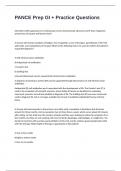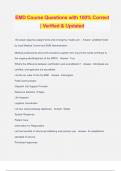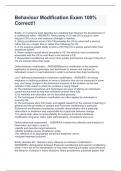PANCE Prep GI + Practice Questions
Ulcerative Colitis appearance on colonoscopy correct answersCrypt abscesses and if toxic megacolon
present loss of haustra and blood vessels
A 63 year-old woman complains of fatigue, loss of appetite, a sore-red tongue, paresthesias of her feet
and hands, and unsteadiness of her gait. Which of the following tests is be used to confirm the patient's
suspected diagnosis?
A Anti-intrinsic factor antibodies
B Antiparietal cell antibodies
C Coomb's test
D Schilling Test
E Serum folate levels correct answersAnti-intrinsic factor antibodies
A diagnosis of pernicious anemia (PA) can be supported through the presence of anti-intrinsic factor
antibodies.
Antiparietal (B) cell antibodies aren't associated with the development of PA. The Coomb's test (C) is
used in the evaluation of hemolytic anemias. Serum folate (D) levels are beneficial in evaluating
macrocytic anemias, but will not establish a diagnosis of PA. The Schilling test (D) was once commonly
used to diagnosis PA, but is no longer available due to lack of available radiolabeled human intrinsic
factor.
A 34-year-old male presents to the primary care office with a complaint of heartburn that has been
present for three months. He has symptoms two to three times a week, which occurs about 30 minutes
after eating. He has tried over-the-counter antacids and they were helping to relieve his symptoms for a
few months, but they are not working well now. He denies dysphagia, odynophagia, or weight loss. You
decide to treat him with a proton pump inhibitor at this visit, and he achieves good symptomatic relief
with this therapy. What length of therapy is appropriate in this patient?
A Two to four weeks
B Eight to twelve weeks
C Four to six months
,D One year
E Continue indefinitely correct answersIf a patient achieves good symptomatic relief with a course of an
empiric, once-daily proton pump inhibitor, therapy may be discontinued after eight to twelve weeks.
A 63 year-old woman complains of fatigue, loss of appetite, a sore-red tongue, paresthesias of her feet
and hands, and unsteadiness of her gait. Which of the following tests is be used to confirm the patient's
suspected diagnosis?
A Anti-intrinsic factor antibodies
B Antiparietal cell antibodies
C Coomb's test
D Schilling Test
E Serum folate levels correct answersAnti-intrinsic factor antibodies
A diagnosis of pernicious anemia (PA) can be supported through the presence of anti-intrinsic factor
antibodies.
Antiparietal (B) cell antibodies aren't associated with the development of PA. The Coomb's test (C) is
used in the evaluation of hemolytic anemias. Serum folate (D) levels are beneficial in evaluating
macrocytic anemias, but will not establish a diagnosis of PA. The Schilling test (D) was once commonly
used to diagnosis PA, but is no longer available due to lack of available radiolabeled human intrinsic
factor.
A 28-year-old man presents for a barium enema; he has a 6-month history of abdominal cramping, pain,
tenesmus, bloody diarrhea, and painful urgency. He also reports arthralgias, but denies a history of
traveling abroad or the use of antibiotics. On physical exam, he has indurated and painful erythematous
plaques and nodules on both shins. An abdominal exam reveals a mild tenderness in the lower left
quadrant (LLQ). Stool exam is positive for occult blood and negative for ova and parasites. Lab analysis
reveals mild leukocytosis, microcytic anemia, positive p-ANCA antibodies, and elevated ESR. What would
be the most likely result of a barium enema?
Answer Choices
1 Apple core appearance
2 Cobblestone appearance
3 Lead pipe appearance
4 String sign
,5 Thumb printing correct answerslead pipe appearance on barium enema
Lead pipe colon is the appearance on barium enema of a foreshortened, narrow colon with loss of
redundancy and haustral markings. This sign is specific for ulcerative colitis (UC), an inflammatory
disease of the rectum and colon. The peak incidence of UC is around 25 to 45 years. P-ANCA antibodies
are associated with UC. Iron deficiency can lead to microcytic anemia. Common extra intestinal
manifestations of UC are erythema nodosum (described as erythematous plaques and nodules on
pretibial areas), arthritis, pyoderma gangrenosum, uveitis, episcleritis, and sclerosing cholangitis.
Toxic megacolon is a complication of UC characterized by the dilation of the colon; there is a risk of
perforation. There is an increased incidence of colon cancer (10%) after 10 years of this disease. The
inflammation involves the mucosal tissues only, which are friable and show ulcerations on colonoscopy.
There is also a characteristic continuous involvement and pseudopolyp appearance caused by mucosal
regeneration. Sulfapyridine, mesalamine, corticosteroids, 6-mercaptopurine, and azathioprine are used
for treatment. Colectomy is curative and is indicated for intractable disease, or in the case of dysplasia.
An apple core appearance on barium enema is seen in patients with colon cancer. This sign refers to the
shouldered margins of the stricture caused by the neoplasmic invasion.
A cobblestone appearance and string sign are characteristic for Crohn's disease, another inflammatory
disease of the digestive tract. The cobblestone appearance refers to the discontinuous areas of
inflammation separated by healthy bowel. String sign, seen in the small bowel series, is the appearance
caused by stricture areas.
Thumb printing is a radiological sign seen in ischemic colitis, a disease most likely found in elde
A 15-year-old boy was healthy until 3 months ago. He has been having episodes of crampy abdominal
pain and explosive liquid stools 2-3 times a day. He has had intermittent fevers and has noted blood in
the stool. He has a documented 15-lb weight loss.
Question
What is the best way to start treatment?
, Answer Choices
1 Diphenoxylate hydrochloride with atropine sulfate
2 Eliminate lactose-containing foods
3 Loperamide HCL
4 Eliminate all high fiber foods
5 Sulfasalazine correct answersSulfasalazine
This patient has ulcerative colitis. Therefore, it would be most appropriate to start treatment with
sulfasalazine at 50-75 mg/kg/day in 2-4 divided doses. Sulfasalazine is a sulfa drug that has important
anti-inflammatory properties because it inhibits the synthesis of mediators of the inflammatory
response. In some patients, sulfasalazine is poorly tolerated, in which case mesalamine (50-100
mg/kg/day) and balsalazide (110-175 mg/kg/day) are preferable treatments.
Diphenoxylate hydrochloride with atropine sulfate at 1-2 mL t.i.d. and loperamide HCl at 0.04-0.08
mg/kg/day in 2-4 divided doses are contraindicated because they would suppress the symptoms of
ulcerative colitis without amelioration of the underlying cause of the condition. Elimination of lactose-
containing food would have no effect because the patient is lactose-tolerant. In addition, elimination of
dietary fiber would not have any effect.
A 15-year-old girl presents with a 1-year history of intermittent abdominal pain with nausea and
occasional bloody diarrhea. She denies fever or weight loss, as well as any travel history. Past medical
history is significant only for migraines. She takes a multivitamin. Her vital signs are within normal limits.
She has mild diffuse abdominal tenderness to palpation and guaiac-positive stool. Her exam is otherwise
normal. Her hemoglobin is 9.7, hematocrit is 28%, and her WBC is 12,000/uL.
Question
What finding would indicate a possible cure if a colectomy is performed?
Answer Choices
1 Skip lesions, transmural involvement on colonoscopy
2 Crypt abscesses, superficial mucosal involvement on colonoscopy
3 Ileal disease






